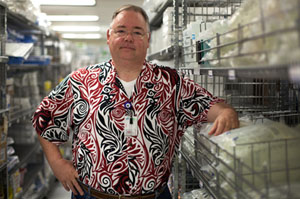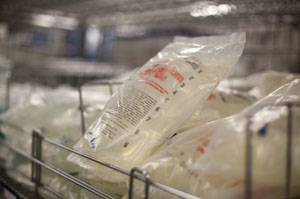Hospitals across the country are struggling to deal with a shortage of one of their essential medical supplies. Manufacturers are rationing saline — a product used all over the hospital to clean wounds, mix medications and treat dehydration. Now drug companies say they won’t be able to catch up with demand until next year.
That leaves San Francisco General Hospital’s materials manager, Reid Kennedy, in a fix. Kennedy is in charge of managing all the gloves, bandages, bedpans and IV solutions for all the medical floors, emergency room and operating room.
He first got a call last year from his vendor telling him they might not be able to deliver his full order.
“We were put on notice that it was going to be tight,” he said.
Then things got worse in January. The flu season hit much harder than expected, and sick people flooded into hospitals. Saline bags flew off the shelves to treat dehydration, and demand far outstripped supply.
“The flu season knocked us out as an industry,” Kennedy said. Though hospital administrators say the shortage hasn’t affected the quality of patient care, Kennedy uses the word “crisis” to describe the shortage.
It’s Harder to Make Than You Think
But can salty water really be that hard to come by? Kennedy pays $1.57 per bag. Why can’t drug companies just whip up some more?
“To make one of these drugs is very complex, even though the drug itself is simple,” said Valerie Jensen, the director of the drug shortage program at the Food and Drug Administration. “It takes about three weeks to make one batch of normal saline from start to finish.”
She says the key challenge is making sure saline products are sterile. More than 30 steps and a range of supplies are involved in producing sterile saline. Jensen says FDA inspectors have reason to keep a close eye on any drug injected intravenously. She says they’ve found some nasty things in IV drugs: bacteria, mold, glass particles.
“These are issues that absolutely would be a safety risk for patients,” she said.
That’s why the FDA sets strict quality standards for the facilities that manufacture saline and other IV drugs. But the agency has to find a delicate balance between safety and supply.
Some suppliers suggest keeping up with the FDA’s standards is too onerous and may be playing a part in the shortage.
“A lot of variables came together to create this,” said Scott Crandall, director of medical supply contracts at Novation, a group buying organization in Texas that manages contracts for San Francisco General and 2,000 other hospitals across the country. He’s been hearing from manufacturers that increased FDA scrutiny is interfering with drug production.
“During the last year, all suppliers had issues in their facilities where they had to correct certain things the FDA found,” Crandall said.
Some of those corrections were serious. Hospira, one manufacturer of saline, issued a recall earlier this year because of leaks in its saline bags. Before that, Baxter, another manufacturer, found particles in its saline vials and had to recall four lots. Both companies say the recalls had no bearing on the current shortage.
Flu Season Causes Headaches
But Crandall says inspections and maintenance require shutting down machines. And when machines aren’t operating, less saline is getting shipped. Last winter, he says maintenance closures “slowed production down, 10 to 20 percent.”
So the industry was already behind when the flu season hit.
The procurement director for a group of dialysis centers says his supplier, Baxter, told him the main problem was winter weather. Snow and ice storms in the Midwest were delaying trucks headed for California.
“As the weather got worse, we began to see more and more back-order issues,” said Colin Carthen of Satellite Healthcare, which runs 70 dialysis centers across the U.S. Each patient comes in three or four times a week, and each time goes through one to two liters of saline to clean the blood and prevent clotting. At the worst of the shortage, Carthen realized the health of 6,000 patients depended on the administrative magic tricks he could perform behind the scenes.
“I called up a clinical person that I knew, and said, ‘Well, what happens if we run out of saline?’ Because I was really afraid,” he remembers. “And they were just like, ‘Yeah, it gets ugly, fast.’”
Carthen says he’s lucky that didn’t happen. Every day, he spent hours on the phone with suppliers and clinical staff, juggling and rerouting supplies so everyone had enough.
Keeping the Supply from Drying Up
Hospitals have developed new clinical protocols to conserve supplies during the shortage. Nurses at San Francisco General are using smaller saline bags when possible, and transitioning patients who still need hydration to drink water from cups a little sooner than they did in the past. Kennedy has spent hours talking with pharmaceutical and clinical staff about when to use these conservation measures, to make sure there is enough saline to go around.
“Pie is a good analogy. Now I’m going to use 16 slices of pie instead of eight slices of pie, and I’ll be able to feed 16 people instead of eight,” he said.
The FDA is trying to mitigate the shortage by importing saline from Spain and Norway. But FDA economist Marta Wosinska says that’s not a sustainable solution, since those countries have to supply their own hospitals.
“There is no spot market. You can’t buy it like pork bellies or grains or oil. You cannot go on a marketplace and order a certain amount,” she said.
U.S. companies also don’t have the capacity to ramp up production. They only have so many machines, and a lot of them are tied up producing other essential drugs. Building new facilities is hardly an option.
“We’re talking about hundreds of millions of dollars and it would take three to five years,” Wosinska said.
The drug companies don’t face any real penalties if they don’t come through with saline supplies. Contract loopholes release them from paying any fees to their customers if a drug shortage is industry-wide, as this one is.
Both Baxter and Hospira, the top two saline producers in the country, say they are doing all they can to maximize production. Each points a finger at the other for contributing to the shortage.
“We saw increased demand amid decreased product availability from competitors as the main driver,” a Baxter spokesman wrote in an email.
A Hospira spokesman countered: “Hospira began seeing stronger demand for its saline products in late 2013 when another manufacturer began to experience manufacturing issues.”
Hospira reported a 20 percent increase in U.S. net sales of its injectable drugs between January and March, citing “increased volume due to competitor supply issues,” in its latest quarterly financial report.
“The Most Expensive Drug Shortage in History”
The burden ultimately falls on hospitals, clinics, and dialysis centers to come up with their own workarounds. And all that staff time adds up. Hospitals spend $216 million a year on the labor costs of managing drug shortages, according to Erin Fox, a professor at the University of Utah College of Pharmacy.
Now that the industry has indicated the saline shortage will extend through the end of the year, Fox estimates this will be the most expensive drug shortage in history.
“IV fluids impact almost every single patient and every single floor. That means you have to educate and get a message out to multiple groups of people rather than a selected group, like for an anesthesia drug or a cancer drug,” Fox said.
For now, the actual cost of saline is steady. Hospitals are protected under contracts that keep prices locked through next year. But Novation’s Scott Crandall says that is very likely to change when those contracts expire.
“The suppliers have already signaled to the market that they plan on increasing price significantly,” he said. “And when I say that, it could double and triple in some aspects.”
Fox says that would be far better than the current situation.
“It is far cheaper for hospitals to pay $3 a bag for saline and have a consistent and quality product — not recalled due to contaminants, or leakage,” she said, “than it is to potentially delay elective surgeries or make workarounds that change weekly or daily due to inconsistent supply.”








